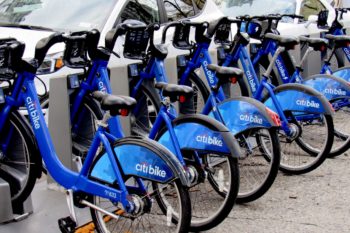
Citi Bikes at a Citi Bike Docking Station./Image Credit: CityLand
This plan includes free bikes and Citi Bike memberships and building one and a half miles of protected bike lanes around 50 New York City high schools in the next year. On September 3, 2020, New York City Comptroller Scott Singer proposed a bike-to-school plan as a sustainable, safe, and healthy transportation option for the city’s young people returning to school this fall amid the COVID-19 pandemic and beyond.
The plan calls for immediate action on behalf of the City and philanthropic partners to provide free bikes and Citi Bike memberships to every low-income high school student in order to combat the reduction in MTA services and the reduced capacity on school buses due to social distancing measures. With 40 percent of high school students attending school within their home districts having an average commute length for a ninth-grader of 31 minutes, Comptroller Stringer believes implementing this program “can allow New York City’s youth to get around their city, improve health and educational outcomes, and connect with their communities.”
The Bike-to-School Plan instructs the City and philanthropic partners to:
– Build one and a half miles of protected bike lanes around all New York City high school buildings. 50 must be completed within one-year, and the remaining ones completed in five years.
– Pedestrianize the block in front of 100 public schools to allow easier access to schools for students. Opening these streets should make it easier for students to access, enter, and park their bikes in front of the school building.
– Provide free Citi Bike memberships to all low-income New York City high school students located within the Citi Bike network. In addition to free membership, the Department of Transportation and Citi Bike should accelerate the timeframe for expanding the Citi Bike network into underserved areas and develop a five-borough plan.
– Provide a free bike to every low-income New York City high school student living or travelling to a school located outside of the Citi Bike network.
– The Department of Education (DOE) should conduct an annual survey of student commutes. This would allow the DOE to ensure riding and walking are safe and easy ways of getting to school.
– Dedicate indoor and outdoor school spaces for bike parking and maintenance. In 2019, 74 percent of New York City high schools were operating below capacity, and once the City emerges from the pandemic, schools with unused space should convert these spaces into indoor and outdoor bike parking, bike maintenance, and courses on maintenance to help students care for their bicycles.
– Expand the bike safety education program to ensure students know how to ride a bike, navigate the city streets, and other basic bike knowledge.
The Bike-to-School Plan provides a socially distanced transportation alternative for high school students during the COVID-19 pandemic and once the City emerges from the pandemic, the Bike-to-School Plan can also significantly improve concentration, cognitive skills, and school performance. In 2017, 29.9 percent of New York City high school students were overweight or obese, and according to the DOE 240,000 out of the city’s 325,000 high school students are in poverty. By providing free bicycles, Citi Bike memberships, and creating the infrastructure needed to support the Bike-to-School Plan, students’ mobility, health, and educational outcomes could be improved.
Several organizations have voiced support for Comptroller Stinger’s plan. Teens Take Charge Director of Strategy Muhameed Deen said “Teens Take Charge is excited to support the Comptroller’s proposal to make transportation equitable for all regardless of their zip code,” and Transportation Alternative Deputy Director Marco Conner DiAqoui said “Biking is a low-cost, healthy, and sustainable transportation tool that more and more New Yorkers are choosing, especially during this pandemic.”
By: Lynsey Smith (Lynsey is the CityLaw intern and a New York Law School student, Class of 2022)

